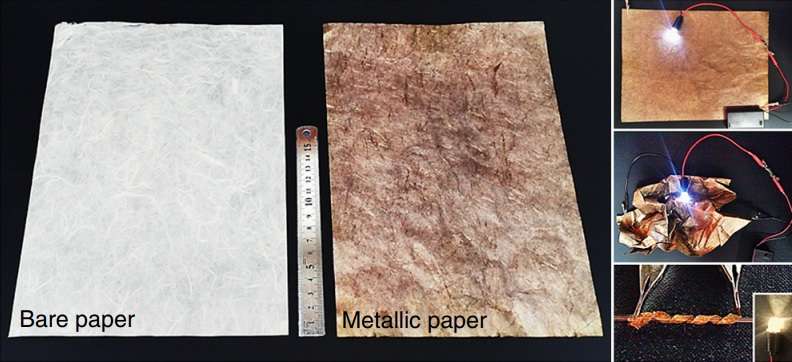September 27, 2017 feature
Paper supercapacitor addresses power/energy density tradeoff

By coating ordinary paper with layers of gold nanoparticles and other materials, researchers have fabricated flexible paper supercapacitors that exhibit the best performance of any textile-type supercapacitor to date. In particular, the paper supercapacitors address one of the biggest challenges in this area, which is to achieve a high energy density in addition to an already high power density, since both properties are essential for realizing high-performance energy-storage devices. In the future, flexible paper supercapacitors could be used in wearable electronics for biomedical, consumer, and military applications.
The researchers, led by Seung Woo Lee at the Georgia Institute of Technology and Jinhan Cho at Korea University, have published a paper on the flexible paper supercapacitor electrodes in a recent issue of Nature Communications.
As energy-storage devices, supercapacitors have several advantages over batteries, such as a higher power density, rapid charge/discharge rate, and longer lifetime, yet they lag behind batteries in energy density (the amount of energy that can be stored in a given amount of space). Although several methods have been attempted to improve the energy density of paper supercapacitors by coating them with various conductive materials, often these methods have the drawback of reducing the power density.
As the researchers explain in their paper, the key to achieving good all-around performance using coating methods is to carefully control the loading amount of the conductive and active materials (such as metal nanoparticles) that are incorporated into the paper supercapacitor and which determine many of its electrochemical properties.
To do this, the researchers used a layer-by-layer assembly process, in which single layers of gold nanoparticles are deposited onto the paper. By selectively alternating between pseudocapacitive layers and metal layers, the researchers could control the loading amount and achieve a high density of nanoparticles, which contributes to a high capacity and high energy density. Another advantage of this method is that the layer-by-layer deposition allows the paper to maintain its highly porous structure, which enhances its performance by providing a short transport route for charged particles.
"The paper electrodes based on layer-by-layer-assembled metal nanoparticles exhibit metal-like electric conductivity, paper-like mechanical properties, and a large surface area without any thermal treatment and/or mechanical pressing," coauthor Yongmin Ko at Korea University told Phys.org. "The periodic insertion of metal nanoparticles within high-energy nanoparticle-based paper electrodes could resolve the critical tradeoff in which an increase in the loading amount of materials to enhance the energy density of supercapacitors decreases the power density."
In experiments, the researchers demonstrated that this assembly method improves several key characteristics of the paper supercapacitor. Its areal performance—which is considered an important factor in evaluating flexible, wearable textile-based energy-storage electrodes—is significantly better than that of any previously reported flexible paper supercapacitor. The maximum areal power and energy densities of the new supercapacitor are 15.1 m/cm2 and 267.3 μWh/cm2, respectively. The researchers expect that these values can be further improved by increasing the number of layers.
Tests also showed that the flexible paper supercapacitors had a maximum capacitance that is higher than any previously reported textile-based supercapacitor. In addition, the new devices exhibits an excellent capacity retention, demonstrated by a 90% capacity retention after 5,000 bending cycles.
The researchers expect that the techniques used here can be applied to paper supercapacitors of various shapes, sizes, and surface areas, as well as supercapacitors based on biomass-derived carbon materials instead of paper, and other types of devices.
"We have now extended our approach to batteries, triboelectric devices, electrochemical sensors, and various other flexible electrodes that require metal-like conductivity and high surface area," Ko said.
More information: Yongmin Ko et al. "Flexible supercapacitor electrodes based on real metal-like cellulose papers." Nature Communications. DOI: 10.1038/s41467-017-00550-3
Journal information: Nature Communications
© 2017 Phys.org



















